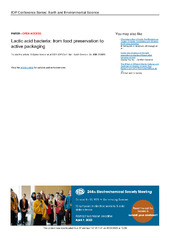Lactic acid bacteria: From food preservation to active packaging
Конференцијски прилог (Објављена верзија)
Метаподаци
Приказ свих података о документуАпстракт
Lactic acid bacteria (LAB) have acted in food fermentations through the ages due to their safety and resilience to specific harsh conditions of high salinity or low pH present in food and gut where they live. Their interaction with human technological development started in food but goes beyond, as some LAB contribute to the health of humans and animals as probiotics. The stress tolerance of LAB also makes them excellent, robust industrial microorganisms for production of lactic acid and other chemicals. The lactic acid market has had a high growth rate in the last decade mainly due to expansion of poly-lactide production. Poly-lactides are biocompatible, thermostable and biodegradable polymers of lactic acid, suitable for use in food packaging or in medicine, as scaffolds, implants or delivery systems. The ability of LAB to grow on complex waste substrates but efficiently produce selected isomers of lactic acid has positioned them at the core of bio-based packaging production, and thi...s field is expected to grow in the future. Therefore, LAB are important for food - for preservation, flavour and packaging, but also beyond food - as probiotics, paraprobiotics and postbiotics. Recent trends in these fields of LAB application are analysed in this work.
Извор:
IOP Conference Series: Earth and Environmental Science, 2021, 854, 1, 012025-Издавач:
- IOP Publishing Ltd
Финансирање / пројекти:
- Министарство науке, технолошког развоја и иновација Републике Србије, институционално финансирање - 200135 (Универзитет у Београду, Технолошко-металуршки факултет) (RS-MESTD-inst-2020-200135)
Колекције
Институција/група
Tehnološko-metalurški fakultetTY - CONF AU - Đukić-Vuković, Aleksandra AU - Mladenović, Dragana AU - Lakićević, B. AU - Mojović, Ljiljana PY - 2021 UR - http://TechnoRep.tmf.bg.ac.rs/handle/123456789/5932 AB - Lactic acid bacteria (LAB) have acted in food fermentations through the ages due to their safety and resilience to specific harsh conditions of high salinity or low pH present in food and gut where they live. Their interaction with human technological development started in food but goes beyond, as some LAB contribute to the health of humans and animals as probiotics. The stress tolerance of LAB also makes them excellent, robust industrial microorganisms for production of lactic acid and other chemicals. The lactic acid market has had a high growth rate in the last decade mainly due to expansion of poly-lactide production. Poly-lactides are biocompatible, thermostable and biodegradable polymers of lactic acid, suitable for use in food packaging or in medicine, as scaffolds, implants or delivery systems. The ability of LAB to grow on complex waste substrates but efficiently produce selected isomers of lactic acid has positioned them at the core of bio-based packaging production, and this field is expected to grow in the future. Therefore, LAB are important for food - for preservation, flavour and packaging, but also beyond food - as probiotics, paraprobiotics and postbiotics. Recent trends in these fields of LAB application are analysed in this work. PB - IOP Publishing Ltd C3 - IOP Conference Series: Earth and Environmental Science T1 - Lactic acid bacteria: From food preservation to active packaging IS - 1 SP - 012025 VL - 854 DO - 10.1088/1755-1315/854/1/012025 ER -
@conference{
author = "Đukić-Vuković, Aleksandra and Mladenović, Dragana and Lakićević, B. and Mojović, Ljiljana",
year = "2021",
abstract = "Lactic acid bacteria (LAB) have acted in food fermentations through the ages due to their safety and resilience to specific harsh conditions of high salinity or low pH present in food and gut where they live. Their interaction with human technological development started in food but goes beyond, as some LAB contribute to the health of humans and animals as probiotics. The stress tolerance of LAB also makes them excellent, robust industrial microorganisms for production of lactic acid and other chemicals. The lactic acid market has had a high growth rate in the last decade mainly due to expansion of poly-lactide production. Poly-lactides are biocompatible, thermostable and biodegradable polymers of lactic acid, suitable for use in food packaging or in medicine, as scaffolds, implants or delivery systems. The ability of LAB to grow on complex waste substrates but efficiently produce selected isomers of lactic acid has positioned them at the core of bio-based packaging production, and this field is expected to grow in the future. Therefore, LAB are important for food - for preservation, flavour and packaging, but also beyond food - as probiotics, paraprobiotics and postbiotics. Recent trends in these fields of LAB application are analysed in this work.",
publisher = "IOP Publishing Ltd",
journal = "IOP Conference Series: Earth and Environmental Science",
title = "Lactic acid bacteria: From food preservation to active packaging",
number = "1",
pages = "012025",
volume = "854",
doi = "10.1088/1755-1315/854/1/012025"
}
Đukić-Vuković, A., Mladenović, D., Lakićević, B.,& Mojović, L.. (2021). Lactic acid bacteria: From food preservation to active packaging. in IOP Conference Series: Earth and Environmental Science IOP Publishing Ltd., 854(1), 012025. https://doi.org/10.1088/1755-1315/854/1/012025
Đukić-Vuković A, Mladenović D, Lakićević B, Mojović L. Lactic acid bacteria: From food preservation to active packaging. in IOP Conference Series: Earth and Environmental Science. 2021;854(1):012025. doi:10.1088/1755-1315/854/1/012025 .
Đukić-Vuković, Aleksandra, Mladenović, Dragana, Lakićević, B., Mojović, Ljiljana, "Lactic acid bacteria: From food preservation to active packaging" in IOP Conference Series: Earth and Environmental Science, 854, no. 1 (2021):012025, https://doi.org/10.1088/1755-1315/854/1/012025 . .



